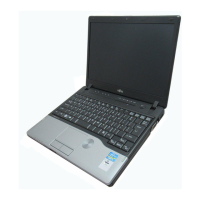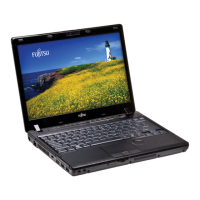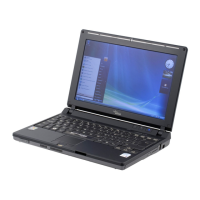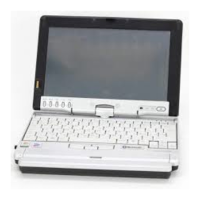Do you have a question about the Fujitsu LifeBook P1120 and is the answer not in the manual?
Statement declaring compliance with FCC Part 15 regulations.
Explains the meaning of various status indicator lights.
Describes the keyboard layout and special keys.
Details the extended functions of keys using the Fn key.
Describes components located on the left side of the notebook.
Describes components located on the right side of the notebook.
Describes components located on the back panel of the notebook.
Describes components located on the bottom panel of the notebook.
Describes the location of physical components on the notebook.
Details the functions of the keyboard keys and keypad.
Describes the states of the power indicator light.
Shows battery charge status and levels.
Explains the available power sources for the notebook.
Guides through powering on and the boot sequence.
Describes the display panel technology and capabilities.
Steps for the initial power-on and OS loading.
Explains options and features for conserving battery power.
Information on opening, adjusting, and closing the display.
Guides on connecting AC and Auto/Airline adapters.
How to turn on the notebook using the Suspend/Resume/Power On button.
Details how to use the button for suspend and resume modes.
Procedure for switching from adapter to battery power.
Methods to adjust screen brightness using keyboard or utility.
Details features for conserving battery power.
Information on configuring system settings via BIOS.
Steps for correctly shutting down the notebook.
Guides on installing and removing PC Cards.
Procedure for identifying and resolving common problems.
Steps to take before pursuing complex troubleshooting.
Lists common problems, their causes, and solutions.
Continues troubleshooting power-related issues.
Continues troubleshooting display screen issues.
Explains common POST error and status messages.
Steps to restore factory image using Drive Image SE.
Guides users to find solutions for specific issues.
Addresses issues when the notebook does not power on.
Solutions for issues with the display screen.
Explains how to use the table to find causes and solutions.
Guidelines for handling, charging, and storing batteries.
Advice on handling, transporting, and protecting the notebook.
Advice on maximizing battery performance and lifespan.
Lists hardware components and environmental requirements.
Lists software pre-installed with the notebook.
Instructions for setting up and using the wireless LAN.
Provides toll-free numbers and contact methods for support.
Information on battery care, charging, and replacement.
Describes various ports like modem, LAN, USB, headphone, mic, mini-VGA.
Procedures for replacing the battery.
Step-by-step guide for installing PC Cards.
Steps to recharge the Lithium ion battery.
Step-by-step guide for removing PC Cards.
Utility for restoring the system to its original factory state.
How to create a custom backup image of the system.
Steps to restore a previously created system image.
FCC compliance and regulatory information for wireless devices.
Describes basic operating procedures for the wireless LAN.
Steps to set up wireless LAN connection for Windows 2000.
Details setting up TCP/IP and checking computer name/workgroup.
Instructions for enabling file and printer sharing on the network.
Verifying connection status, channel, and signal strength.
Information on causes and actions for wireless LAN problems.
Information on IP addresses and network configuration.
Outlines the steps required for proper wireless LAN setup.
Steps to configure IP address and DNS server settings.
Steps to enable sharing for Microsoft Networks.
Steps to set up wireless LAN connection for Windows XP.
Lists common wireless LAN problems, causes, and solutions.
Guides on setting IP addresses automatically or manually.
Details FCC limits and measures to correct interference.
Explains AdHoc and Infrastructure network modes.
Steps to set profiles and encryption for wireless connection.
Example steps for sharing a folder on the network.
Outlines the steps required for proper wireless LAN setup.
Information on RF exposure limits and maintaining safe distances.
Steps to set up printer sharing for network access.
Steps to set network name (SSID) and encryption keys.
Verifying the connectivity of the wireless LAN network.
Steps to access shared drives on other network computers.
Lists technical specifications for the wireless LAN device.












